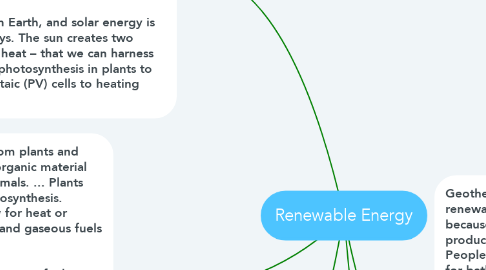Renewable Energy
by nourin elkhatib

1. Solar energy is radiant light and heat from the Sun that is harnessed using a range of ever-evolving technologies such as solar heating, photovoltaics, solar thermal energy, solar architecture, molten salt power plants and artificial photosynthesis. It is an essential source of renewable energy, The main advantage is that it is a renewable, clean source of electricity. Solar power is also scalable. ... When it's used on a small scale, extra electricity can be stored in a battery or fed back into the electricity grid. Overall, the sun gives off far more energy than we'll ever need. Our sun is the source of all life on Earth, and solar energy is useful to us in many different ways. The sun creates two main types of energy – light and heat – that we can harness for many activities ranging from photosynthesis in plants to creating electricity with photovoltaic (PV) cells to heating water and food
2. Biomass—renewable energy from plants and animals Biomass is renewable organic material that comes from plants and animals. ... Plants produce biomass through photosynthesis. Biomass can be burned directly for heat or converted to renewable liquid and gaseous fuels through various processes. Biomass continues to be an important fuel in many countries, especially for cooking and heating in developing countries. ... Biomass contains stored chemical energy from the sun. Plants produce biomass through photosynthesis Biomass, a renewable energy source derived from organic matter such as wood, crop waste, or garbage, makes up 4.8 percent of total U.S. energy consumption and about 12 percent of all U.S. renewable energy. Wood is the largest biomass energy source
3. Biomass—renewable energy from plants and animals Biomass is renewable organic material that comes from plants and animals. ... Plants produce biomass through photosynthesis. Biomass can be burned directly for heat or converted to renewable liquid and gaseous fuels through various processes. Biomass continues to be an important fuel in many countries, especially for cooking and heating in developing countries. ... Biomass contains stored chemical energy from the sun. Plants produce biomass through photosynthesis Biomass, a renewable energy source derived from organic matter such as wood, crop waste, or garbage, makes up 4.8 percent of total U.S. energy consumption and about 12 percent of all U.S. renewable energy. Wood is the largest biomass energy source
4. Wind power or wind energy is the use of wind to provide mechanical power through wind turbines to turn electric generators for electrical power. Wind power is a popular sustainable, renewable source of power that has a much smaller impact on the environment compared to burning fossil fuels. It does not contaminate, it is inexhaustible and reduces the use of fossil fuels, which are the origin of greenhouse gasses that cause global warming. Over the past 10 years, U.S. wind power capacity has grown 15% per year, and wind is now the largest source of renewable power in the United States
5. Geothermal energy is a renewable energy source because heat is continuously produced inside the earth. People use geothermal heat for bathing, to heat buildings, and to generate electricity. its source is the almost unlimited amount of heat generated by the Earth's core. Even in geothermal areas dependent on a reservoir of hot water, the volume taken out can be reinjected, making it a sustainable energy source. Geothermal hot water can be used for many applications that require heat. Its current uses include heating buildings (either individually or whole towns), raising plants in greenhouses, drying crops, heating water at fish farms, and sev


